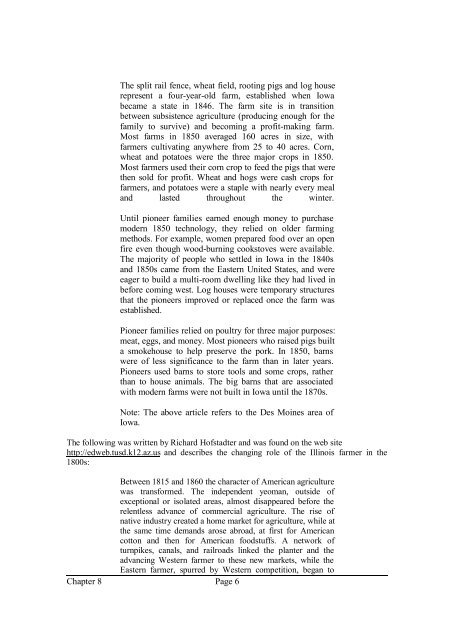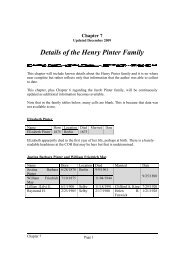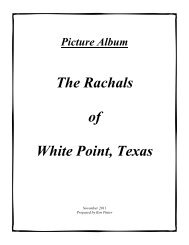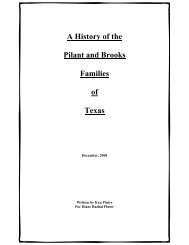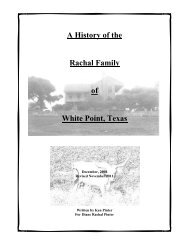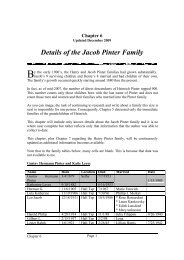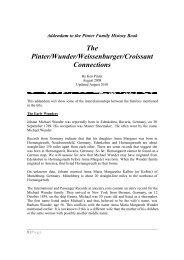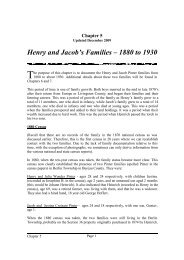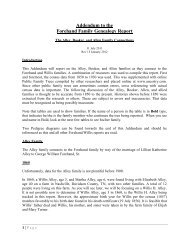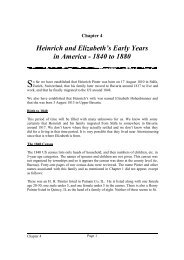Early Farm Life in Bureau County, Illinois, and ... - New Page 1
Early Farm Life in Bureau County, Illinois, and ... - New Page 1
Early Farm Life in Bureau County, Illinois, and ... - New Page 1
Create successful ePaper yourself
Turn your PDF publications into a flip-book with our unique Google optimized e-Paper software.
The split rail fence, wheat field, root<strong>in</strong>g pigs <strong>and</strong> log house<br />
represent a four-year-old farm, established when Iowa<br />
became a state <strong>in</strong> 1846. The farm site is <strong>in</strong> transition<br />
between subsistence agriculture (produc<strong>in</strong>g enough for the<br />
family to survive) <strong>and</strong> becom<strong>in</strong>g a profit-mak<strong>in</strong>g farm.<br />
Most farms <strong>in</strong> 1850 averaged 160 acres <strong>in</strong> size, with<br />
farmers cultivat<strong>in</strong>g anywhere from 25 to 40 acres. Corn,<br />
wheat <strong>and</strong> potatoes were the three major crops <strong>in</strong> 1850.<br />
Most farmers used their corn crop to feed the pigs that were<br />
then sold for profit. Wheat <strong>and</strong> hogs were cash crops for<br />
farmers, <strong>and</strong> potatoes were a staple with nearly every meal<br />
<strong>and</strong> lasted throughout the w<strong>in</strong>ter.<br />
Until pioneer families earned enough money to purchase<br />
modern 1850 technology, they relied on older farm<strong>in</strong>g<br />
methods. For example, women prepared food over an open<br />
fire even though wood-burn<strong>in</strong>g cookstoves were available.<br />
The majority of people who settled <strong>in</strong> Iowa <strong>in</strong> the 1840s<br />
<strong>and</strong> 1850s came from the Eastern United States, <strong>and</strong> were<br />
eager to build a multi-room dwell<strong>in</strong>g like they had lived <strong>in</strong><br />
before com<strong>in</strong>g west. Log houses were temporary structures<br />
that the pioneers improved or replaced once the farm was<br />
established.<br />
Pioneer families relied on poultry for three major purposes:<br />
meat, eggs, <strong>and</strong> money. Most pioneers who raised pigs built<br />
a smokehouse to help preserve the pork. In 1850, barns<br />
were of less significance to the farm than <strong>in</strong> later years.<br />
Pioneers used barns to store tools <strong>and</strong> some crops, rather<br />
than to house animals. The big barns that are associated<br />
with modern farms were not built <strong>in</strong> Iowa until the 1870s.<br />
Note: The above article refers to the Des Mo<strong>in</strong>es area of<br />
Iowa.<br />
The follow<strong>in</strong>g was written by Richard Hofstadter <strong>and</strong> was found on the web site<br />
http://edweb.tusd.k12.az.us <strong>and</strong> describes the chang<strong>in</strong>g role of the Ill<strong>in</strong>ois farmer <strong>in</strong> the<br />
1800s:<br />
Between 1815 <strong>and</strong> 1860 the character of American agriculture<br />
was transformed. The <strong>in</strong>dependent yeoman, outside of<br />
exceptional or isolated areas, almost disappeared before the<br />
relentless advance of commercial agriculture. The rise of<br />
native <strong>in</strong>dustry created a home market for agriculture, while at<br />
the same time dem<strong>and</strong>s arose abroad, at first for American<br />
cotton <strong>and</strong> then for American foodstuffs. A network of<br />
turnpikes, canals, <strong>and</strong> railroads l<strong>in</strong>ked the planter <strong>and</strong> the<br />
advanc<strong>in</strong>g Western farmer to these new markets, while the<br />
Eastern farmer, spurred by Western competition, began to<br />
Chapter 8 <strong>Page</strong> 6


